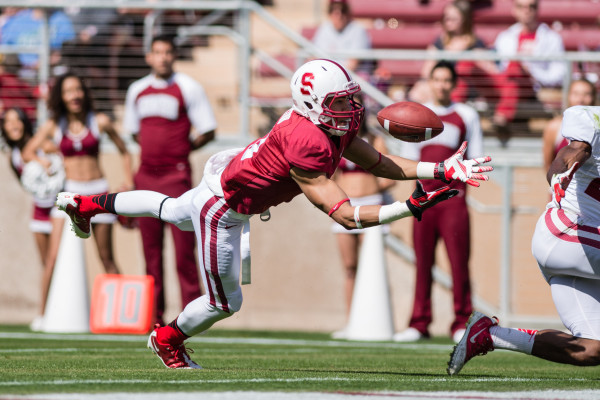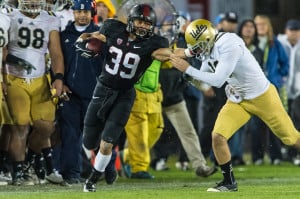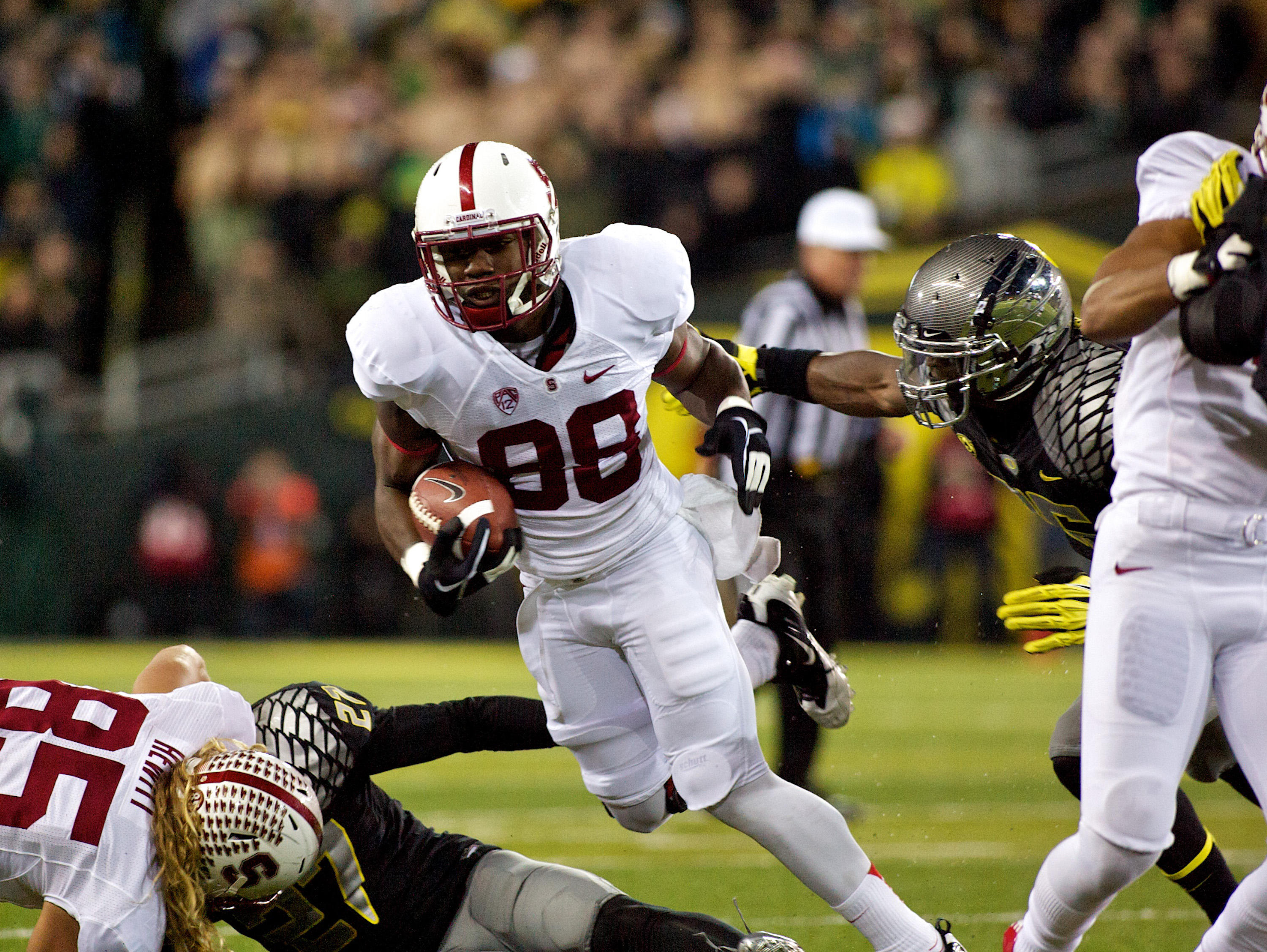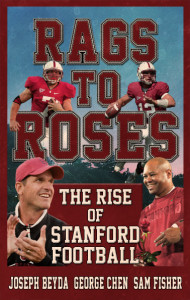The 2013 Rose Bowl Game has begun.
Stanford faces a first-and-10 at midfield on the game’s opening drive. The offense lines up in the Wildcat formation, with running back Anthony Wilkerson awaiting the snap. Most of the Cardinal’s Wildcat plays over the past two seasons have been neither successful nor exciting, usually ending with a mundane 1- or 2-yard gain up the middle. But with a month to prepare for The Granddaddy of Them All, the coaching staff has added a new wrinkle.
Anthony takes the snap and hands it off to Kelsey Young, who then pitches it to Drew Terrell in the backfield. Terrell knows exactly what to do — he’s had prior experience when it comes to game-day passes, after all — and the team has executed this play multiple times in the last month of practice. After setting his feet, Terrell launches the ball deep downfield toward wide receiver Jamal-Rashad Patterson.
Maybe he shouldn’t have.
Wisconsin safety Shelton Johnson isn’t fooled at all by the trick play, going toe-to-toe with Patterson right from the start. But as the ball approaches the two players, Patterson, with Johnson still draped all over him, leaps into the air, hauls in the ball and then maintains possession as he hits the ground hard. Patterson’s circus catch turns an easy interception by the safety into a breathtaking 34-yard gain.
Two plays later, Young scampers into the end zone for a 16-yard touchdown to put up the first points of the game.

Patterson’s SportsCenter Top 10-worthy reception perfectly embodies the electric, game-changing play at wideout that the Cardinal has rarely produced for the last two seasons. The program’s lackluster receiver production has become a weakness that is as glaring as its strengths — there’s a reason why Stanford is known as Quarterback U and Tight End U, not Wideout U.
Going into last season, two of the biggest question marks for the Cardinal surrounded the secondary and wide receiver positions. Free safety Ed Reynolds and company rose to the occasion with lights-out coverage that produced 15 interceptions. On the other hand, the receiver corps, not counting the wideout-tailback hybrid Young, accounted for less than 35 percent of Stanford’s receiving yards and mustered just six of the Cardinal’s 19 passing touchdowns. Over one nine-game stretch, Patterson was the only wideout who caught a touchdown pass. As the desperate need for some spark at the receiver position continued to hang over the Cardinal offense, fans could do nothing except nostalgically remember the playmaking abilities of Ryan Whalen, Doug Baldwin and Chris Owusu. In 2012, the receivers fell flat.
But 2013 could be the turning point.
“We feel like it’s our time to step up,” said sophomore receiver Kodi Whitfield, “to prove that we can make some plays on offense and be a valuable part to this team. We’ve always felt like we could contribute in games, with guys like Drew Terrell and Jamal-Rashad Patterson last year — they were huge for us last year in some big games.”
Both Terrell and Patterson are gone, and junior Ty Montgomery is the only returning receiver who had double-digit receptions last season. Whitfield, who saw action as a true freshman, is second on the list with two receptions for 13 yards. But despite the Cardinal’s inexperience at wideout, there is an air of excitement surrounding the position at fall camp — one that was noticeably absent the last two years.
“I think it’s an exciting challenge because our wide receiver play has sort of curtailed over the last couple years with the departure of the Whalens and Baldwin,” said quarterbacks and wide receivers coach Mike Sanford. “Of course, we relied heavily on our tight end play, but we’re really excited about what the receiver group can be. Just to be able to work with a group that doesn’t have a lot of experience and didn’t have a lot of confidence going in, but now is slowly building tremendous confidence because they’re a highly talented group, that’s exciting.”
Before fall camp even started, head coach David Shaw named Montgomery and junior Devon Cajuste as his two starting receivers. Shaw stated that Montgomery, who was limited by a nagging leg injury last season, is faster than he was his freshman year, while Sanford likened Cajuste’s long, 6-foot-4 frame to that of former Stanford tight end and All-American Coby Fleener. Though Cajuste only caught one pass for 7 yards in 2012, the coaches were impressed enough with his improvement during the offseason to award him the starting “X” receiver spot.
However, the Cardinal’s biggest X-factor this year might be Kelsey Young. The speedy junior attended the same high school in Norco, Calif., as former Stanford running back Toby Gerhart did, and though their running styles could not be more different, Young has already proven to be a deadly weapon on fly sweeps and screens. Young came to the Farm as a running back, but learned the ropes of the wideout position during spring ball of his freshman year; in 2012, he rushed for 160 yards on just 14 carries and picked up 74 yards on eight receptions. And while the dynamic playmaker still expects to see action in the running game this season, he currently spends the majority of practice with the receivers. The team has a special name for Young’s hybrid role: the “KY” position.
“I want to make that position an official position,” Young said. “I want to make that something everyone uses, just like the tailback position.”

Young has gained a better understanding of his position by watching film on other great college players who adopted similar roles for their teams: Percy Harvin, Tavon Austin and Reggie Bush. Though Young has yet to match the production put up by those three electric playmakers, blurring speed is certainly something that he has in common with them. When asked who the fastest player on the team was, Young, without even the slightest hint of hesitation, replied, “Kelsey Young.”
While inexperience may be an issue for this year’s receiver corps, depth certainly is not. Michael Rector, Jordan Pratt, Jeff Trojan and Whitfield all impressed during spring ball; in Saturday’s scrimmage, both Rector and Pratt gave a glimpse of what this season could hold for the group when they each snagged a 40-yard reception.
“I think [confidence] is something that’s been missing,” Rector said. “But I think that’s something the receiver corps as a whole has really incorporated into the team this year. I think we have a lot of people who can stretch the field.”
Coach Sanford brings a wealth of knowledge from his prior experiences as a Boise State quarterback, but the wideouts have an additional resource in Shaw. A former Cardinal receiver who played on the Farm from 1991-94, the head coach sometimes pulls the wideouts aside to give them specific tips.
“At meetings and on the field, [Shaw] helps us with the little intricacies of routes and how to run routes, and he makes us better,” Rector said. “He tries to show us what he used to do and that helps us.”
“It’s not what you think.” Whitfield joked. “When you talk to the head coach, you’re not in trouble.”
Whitfield himself feels more confident and comfortable with a season of playing experience under his belt, and there’s reason to believe that his development is representative of the receiver group’s improvement this offseason as a whole.
“Last year playing as a freshman, it gave me some valuable experience,” Whitfield said. “Playing on game day is a lot different than practice, as you’d assume. This year, I’ve definitely calmed my nerves from last year. There’s not so much hesitation or uncertainty playing out there. I feel like I’m playing faster and more sure of myself now.”
While impressive spring game performances and scrimmage showings are always promising signs, none of that will matter if the Cardinal receivers don’t produce during the season. The departures of Zach Ertz and Levine Toilolo have brought a new — and perhaps troubling — uncertainty to how much the tight ends can contribute to the passing game. So unless the offense wants to run Spider 3 Y Banana with fullback Ryan Hewitt on every passing play, the proverbial light better come on fast for the receivers. It’s clear, though, that the group has taken the first step toward accomplishing its goal by eagerly taking up the gauntlet.
“We put a lot of responsibility on ourselves — all the pressure on ourselves,” Rector said, “because we haven’t been known as a team that has really good receivers. We don’t like that. We want to change that.”
“This year, we want that load to be on us,” Whitfield added.
Contact George Chen at gchen15 “at” stanford.edu.
Previous installments in our 2013 football season preview:
Aug. 26: Without Taylor, the Cardinal stable re-opens
Aug. 25: Anderson, Stanford defensive line look to wreak havoc once again
Aug. 20: Tarpley, Skov and Murphy headline Stanford’s elite linebacker corps
Aug. 19: Upstart tight ends look to fill void left by Ertz, Toilolo
Aug. 14: Hogan embraces leadership role, ready to take the next step
Aug. 13: Offensive line powers forward, seeks new center
Want to learn about Chris Owusu’s mentorship of Ty Montgomery during the 2011 season? Read about how Owusu played a role in the Cardinal’s success despite being sidelined by concussions in “Rags to Roses,” available in the Amazon Kindle store now! Stanford Daily football beat writers Joseph Beyda, George Chen and Sam Fisher interviewed 30 current and former players and coaches to bring you the story of the Cardinal’s resurgence from 2006 to 2012. You can also check out the free excerpts here.

